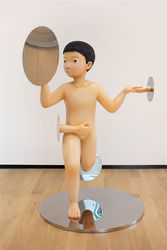Installation View




Featured Artists
Tang Contemporary Art presents at Art Basel Hong Kong 2022 recent works by some of the most critical artists from China and Southeast Asia, including Ai Weiwei, Yue Minjun, Zhao Zhao, Li Qing, Qin Qi, Jigger Cruz, Pannaphan Yodmanee, Yunizar, Woo Kukwon, Kitti Narod and Gongkan.
Ai Weiwei and Yue Minjun, both leading contemporary artists of China, appropriate Chinese traditionality and Cynical Realism respectively to synchronously convey critical views on China’s societal issues. Imageries of pleasant objects and laughter faces are only superficial, awaiting your decodation to find deeper, enlightening messages. Emerging artist Zhao Zhao employs a similar approach, manipulating ordinary subject matter like cotton in his “Spread” series for extraordinary political propositions. Meanwhile, artists like Li Qing and Qin Qi may focus on a world more emotionally driven. With the former using windows as his compositional mainstay and the latter utilizing the traditional oil painting technique, they both depict a Chinese society intermingled with surreal and imaginary elements.
Southeast Asian artists, while showing interest in different subject matters from their Chinese counterparts, may share analogous artistic philosophies. Pannaphan Yodmanee, Yunizar, and Woo Kukwon express their unique perceptions of a society – their society – inseparable from traditionality, longstanding culture, and collective identity such as mythology. Nevertheless, this traditionality may also be the bullseye of critique like that in Ai Weiwei’s works. To do so, Jigger Cruz vandalizes, fragmentizes, and even destroys classical imagery, devaluing them and stirring up an internal revolution. Kitti Narod and Gongkan then proceed further to describe a world of modernity and advancement, using pop and vibrant styles to illustrate the importance of communication and self-actualization.
Dynamic yet resonating with one another, these works by 11 artists are selected meticulously to illuminate the images of two societies – China and Southeast Asia. Such a “juxtaposition” reveals both their parallels and their distinctions, in terms of what could be criticized and what could be prospected. It allows us to observe and thus fathom comprehensively the now ever-changing and rapidly developing Asian contemporary art scene.
















